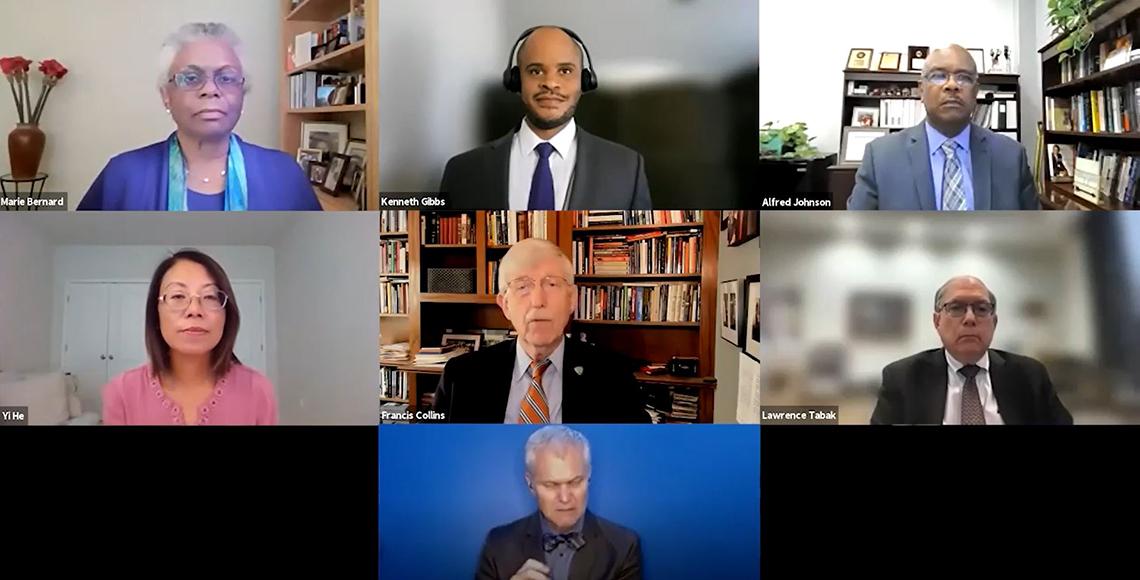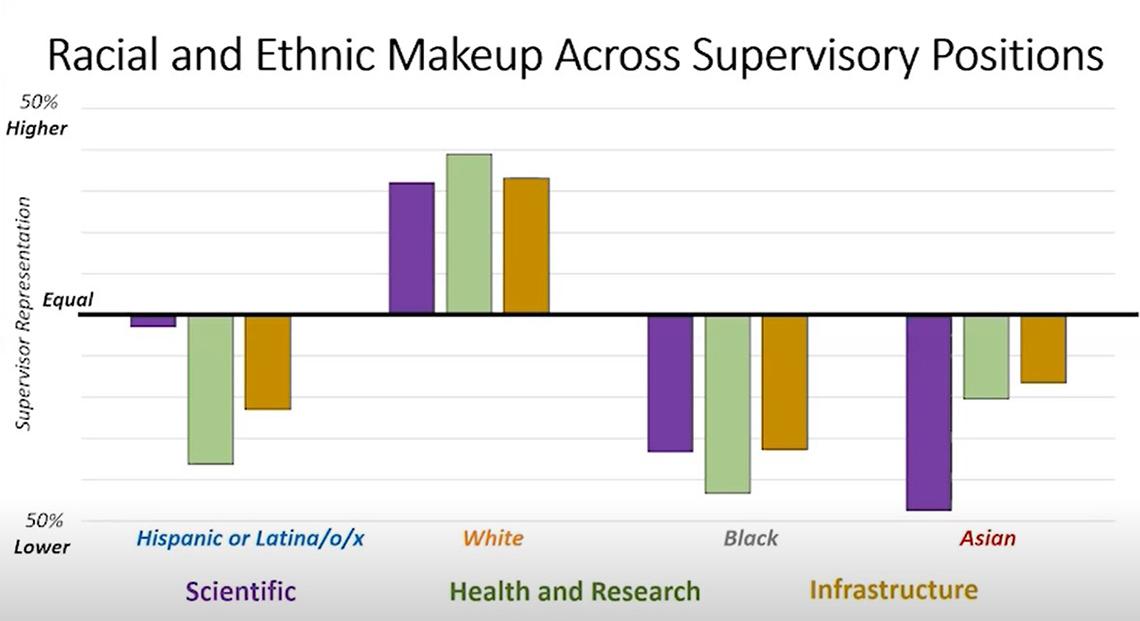UNITE Makes Progress, Cites Long Way to Go

Photo: Chia-Chi Charlie Chang
Racism threatens NIH’s mission, which seeks “fundamental knowledge about the nature and behavior of living systems, and the application of that knowledge to enhance health, lengthen life and reduce illness and disabilities with and for all people,” said then-NIH director Dr. Francis Collins.
“Although it’s daunting to consider how to fix the damage inflicted by more than 400 years of structural racism and ethnic discrimination in this country, we are committed to implementing improvements with the resources of the world’s largest supporter of biomedical research,” Collins said on Nov. 17 at the second virtual Town Hall on Achieving Racial and Ethnic Equity at NIH.
He’s proud of the work the UNITE Initiative and the anti-racism steering committee (ARSC) have done “to help ensure that our structures and our culture reflect the justice and the equity that all of us deserve.” He thanked his colleagues in the Eight Changes for Racial Equity (8CRE) group and to senior Black investigators, “who encouraged NIH leadership to shift mindsets and push equitable change forward.”
Recently, NIH rescinded a Notice of Special Interest, which was intended solely to call attention to the presence of a specific funding opportunity announcement and encourage researchers from underrepresented groups to apply.
While well-intentioned, the notice raised “legal concern under federal law,” said NIH principal deputy director and UNITE co-chair Dr. Lawrence Tabak. Some researchers thought “that applications from scientists from underrepresented groups would somehow automatically be prioritized for funding.”

Additionally, three components issued the notice, which gave the misimpression that only those institutes “were interested in diversifying the biomedical research workforce,” which, Tabak noted, “is not correct.”
Tabak apologized for the poor communication about the notice. He said NIH will continue to vigorously address the funding gap for Black and African American researchers.
NIH, in coordination with all 27 institutes and centers, issued a new notice on Oct. 25 to confirm everyone’s collective commitment to ensuring a wide range of diverse perspectives are represented in NIH-supported research.
“NIH is committed to doing our best to ensure that we are all listening and talking to each other more effectively,” said Tabak. “We must do better going forward.”
Since launching in late 2020, the UNITE Initiative has worked to create a sense of belonging, promote social accountability and restructure key processes, said Dr. Marie Bernard, NIH’s chief officer for scientific workforce diversity and UNITE co-chair.
“This, of course, would not be feasible, were it not for the 80-plus volunteers involved with the initiative, and all the others who’ve been supporting it,” she said. “People have been selfless in giving their time and energy to move things forward.”
NIH has taken steps to create a more inclusive biomedical workforce. ARSC was established to help address racial and ethnic equity across NIH. Bernard noted more than 500 full-time employees, contractors and trainees have volunteered toward the effort.
This past fall, the NIH Common Fund’s Faculty Institutional Recruitment for Sustainable Transformation program announced its first award recipients. It aims to increase the representation of faculty from underrepresented groups in biomedical science. The fund has also developed the Transformative Research to Address Health Disparities and Advance Health Equity initiative, which funds innovative research that prevents, reduces or eliminates health disparities and inequities.
Bernard said NIH updated its anti-harassment website and training modules now address harassment based on “race, nationality, and sexual orientation.” New artwork was installed in NIH buildings to highlight the diversity of staff to promote a sense of inclusivity and belonging.
The Office of Extramural Research has also released data “about our funded investigators by race, ethnicity and disability in addition to the data that was already available by gender and career stage,” Bernard said. The Office of Equity, Diversity and Inclusion has posted demographic data about NIH’s workforce that includes information about race, ethnicity, sex and disability status.
“We’re working very hard on being as transparent as possible,” she said.
UNITE recommended that NIH update the policy manual chapter on preventing and addressing harassment and inappropriate conduct to make clear that all types of harassment—not just sexual harassment—are covered. Also, racial discrimination can now be reported through ERA Commons. And IC directors must focus on diversity, equity, inclusion and accessibility as a component of their FY22 Performance Management Appraisal Program.
“NIH is a diverse workplace—46 percent of our staff are what people typically term ‘people of color,’” said NIGMS’s Dr. Kenneth Gibbs, a UNITE member.
The analysis of workforce data does not include demographic information on contractors, even though they make up 42 percent of the workforce.
“Because contractors are not NIH employees, we don’t actually have access to the demographic information that we have for employees,” he said. “We are exploring avenues to collect data on contractors.”
There are hiring disparities at NIH. Gibbs noted that while almost 11 percent of White candidates whose applications were referred to a hiring manager were selected, only 5.6 percent of Black candidates whose applications were referred were selected.
Black, Hispanic and Latina/o/x and Indigenous employees are poorly represented in scientific positions, he explained, even though NIH has invested money to develop a strong and diverse biomedical workforce.
“We have a robust talent pool of well-trained scientists. It’s up to NIH to ensure that we are an environment that can attract and cultivate this diverse group of scientists,” Gibbs said.
As GS levels increase, especially above GS level 10, White staff become better represented at each grade, while Black staff become more poorly represented. Gibbs noted “a more oscillating pattern for staff from other racial and ethnic groups.” Additionally, White employees are represented 30 to 40 percent greater in supervisory positions than they are in the workforce.

The initiative is thinking about how to create more career and professional development opportunities for staff under GS-11. “Given that this group is more than 60 percent people of color, this is an example of structural change that can enhance opportunity for diverse NIH staff,” he remarked.
Gibbs concluded: “Data are so important because representation and equity are measurable constructs. We want to use these data as a baseline to assess what has come from UNITE efforts.”
NHLBI’s Yi He joined ARSC “to help instill change to ensure that everyone within NIH has the same chances to succeed.”
He said efforts to fight systemic racism will always be met with resistance, meaning the path forward will be hard. Despite that, she is hopeful for a few reasons.
About 37 percent of employees on the committee are White, meaning “quite a few White employees are aware of the issues we face pertaining to racism and are motivated enough to volunteer in making a change,” she said.
He said seeing her fellow members take action is “exhilarating” and “the support we get from NIH leadership is genuine.”
Going forward, UNITE and ARSC will continue to provide guidance and recommendations to leadership, said NIH deputy director for management and UNITE co-chair Dr. Alfred Johnson.
Staff in NIH’s Division of Program Coordination, Planning and Strategic Initiatives are drafting a strategic plan to address diversity, equity, inclusion and accessibility. The plan will acknowledge the changes ICs are making.
In addition, he said experts from outside the agency will consult with IC leadership to help develop racial and ethnic equity plans by April 2022.
“We are eager to work with each of you,” said Johnson. “You all have voices that need to be heard.”
NIH’ers can learn more at: https://employees.nih.gov/pages/ending-structural-racism/. To watch the full town hall, visit: https://videocast.nih.gov/watch=44104.
